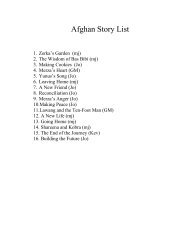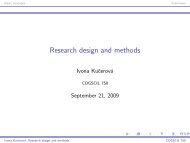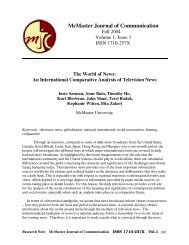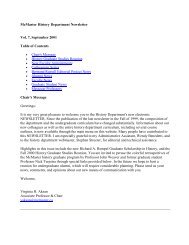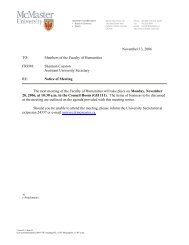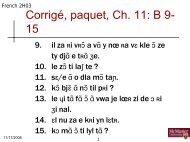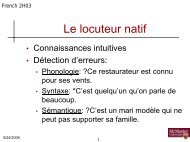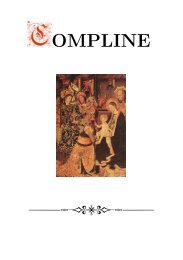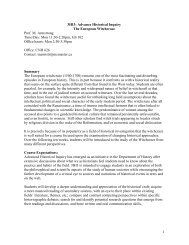Evaluating Primary Sources and Connecting them to Secondary
Evaluating Primary Sources and Connecting them to Secondary
Evaluating Primary Sources and Connecting them to Secondary
Create successful ePaper yourself
Turn your PDF publications into a flip-book with our unique Google optimized e-Paper software.
Part B: Finding Relevant <strong>Secondary</strong> <strong>Sources</strong><br />
Using the secondary source search skills we have reviewed in class (in library on 24<br />
September):<br />
a) Find one, peer reviewed journal article on your <strong>to</strong>pic from an academic<br />
journal (not a review article or a book review) that McMaster Library owns<br />
(print or online). Provide a citation using Chicago Manual of Style Online<br />
(notes <strong>and</strong> bibliography system). Do not select an article that is already part<br />
of the course reading.<br />
b) Read the article, not just the abstract. Outline the main argument of the<br />
author (50-100 words). Copying the existing abstract is not acceptable.<br />
c) Look at the references in the article. Select <strong>and</strong> find one of the sources. You<br />
should try <strong>to</strong> find another peer-reviewed article.Provide a citation according <strong>to</strong><br />
the Chicago Manual of Style Online.<br />
d) Outline the main argument of the author (50-100 words).<br />
In the unlikely event that you cannot find a peer reviewed article as one of the<br />
sources, please contact me.<br />
End this section with a restatement or revision of the research question, as<br />
appropriate. A restatement indicates that you still find the original research question<br />
your best guide, a revision indicates your thinking is changing. There is no “better”<br />
answer here. In some cases, a revision will be better, in others a restatement is<br />
appropriate.<br />
PART C: Websites as sources of primary material<br />
Select two of the websites listed below.<br />
• Peace <strong>and</strong> War in the 20th Century, http://pw20c.mcmaster.ca/<br />
• Canadian Great War Project, http://www.canadiangreatwarproject.com/index.asp<br />
• Canadian Letters <strong>and</strong> Images Website, http://www.canadianletters.ca/<br />
• Library <strong>and</strong> Archives Canada, Military <strong>and</strong> Peacekeeping,<br />
http://www.collectionscanada.gc.ca/war-military/index-e.html<br />
• National Archives [UK], Looking for records of the First World War,<br />
http://www.nationalarchives.gov.uk/records/looking-for-subject/firstworldwar.htm<br />
• Imperial War Museum, http://www.iwm.org.uk/collections/search<br />
• National Archives of Australia http://www.naa.gov.au/index.aspx<br />
Analyze two of these websites, using what you determine are the most important<br />
evaluation criteria (at least three) in determining the quality of the documentary <strong>and</strong><br />
other material found on <strong>them</strong>. We will be discussing evaluation criteria during class on<br />
15 Oc<strong>to</strong>ber.<br />
The final line of your analysis should indicate whether/how this website is relevant <strong>to</strong><br />
your research question. If you find that one of the websites is not so relevant, that is<br />
fine. If none of <strong>them</strong> seem relevant, please contact me.<br />
At the <strong>to</strong>p of your critique, provide the citations for the two sites you have selected using




